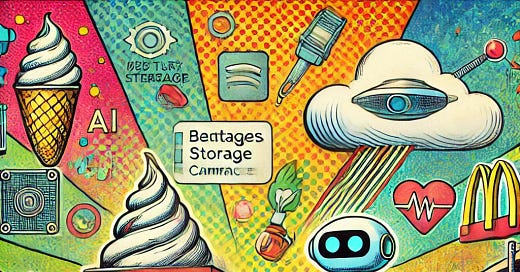Alright, folks, let’s talk about the world today—AI, robots, politics, and a McFlurry machine that works...or, well, doesn’t work. I mean, we’re living in an age where everything’s supposed to be instant, right? Instant messages, instant transactions, even instant salad assembly. But, you gotta ask, are things really getting easier? Or is it like the McFlurry machine at 11 p.m. on a Saturday night—unavailable when you need it most?
Take AI in healthcare. It's promised to cut through the red tape, help us understand our medical gobbledygook, maybe even help book that ever-elusive specialist appointment. But let’s face it, folks, AI's biggest impact right now is on the paperwork. You got test results you can’t understand? AI’s got you covered...kind of. It’s like hiring an assistant who organizes your mess but doesn't actually fix it. You still need the doc to tell you if you’re healthy or if you just need to lay off the extra espresso shots…..Then, you’ve got these new AI tools rolling out—helping people skip the “reply-all” chaos in the inbox, and make sense of Slack threads. They’re even drafting emails. I mean, what’s next? AI apologizing to your boss for that "accidental" vacation photo? Meanwhile, over in the phone department, people don’t even want AI if it means paying extra. But give them a better battery, more storage, or a camera that can actually make us look better on video calls, and they’re sold!
And let’s not forget the robots, because, you know, they’re everywhere. Agility Robotics? These guys are making robots that can move totes around Amazon warehouses. Now, these bots don’t need a break, don’t call in sick, and they’re the perfect employees—until they start demanding fair charging stations…..And as if that wasn’t enough, we’ve got McDonald's...still trying to get the McFlurry machine to stop breaking. We can create humanoid robots for a warehouse but can’t fix the soft-serve machine in 2024? It’s not adding up, people!
So here’s the takeaway: tech is moving fast, but it’s like we’re living on a hamster wheel of upgrades, subscriptions, and promises for “next time.” AI might be the next big thing, but only if it’s affordable and doesn’t make us work harder just to use it. So go ahead, folks—embrace the bots, draft those auto-responses, and order that McFlurry while you still can...if it’s available, all while you read those stories, and more, all here today, in THE COMUNICANO!!!
Andy Abramson
AI Watch
Get Reading—Read AI has raised $50 million in a Series B round to expand its AI co-pilot capabilities across multiple communication platforms, including Slack, email, and enterprise tools like Salesforce and HubSpot. Led by Smash Capital, this funding supports Read AI's aim to simplify work communication through generative AI-powered summarizations and actionable briefings, helping users navigate emails, meetings, and chats more efficiently. New features, like Read AI for Gmail, streamline workflow by summarizing key points and drafting responses directly in the inbox, making it a versatile assistant for digital communication management. Read AI is also offering a Chrome extension for free.
The Doctor is Out—AI is expected to streamline the administrative side of U.S. healthcare faster than direct medical care. While AI’s potential to drive medical research and individualize patient treatment is real, its immediate impact lies in helping people navigate the complex healthcare system. Early adopters like Shasta Kearns Moore use tools like ChatGPT to decode test results and manage paperwork, highlighting AI’s role in easing healthcare’s bureaucratic burdens. Yet, AI’s effectiveness depends on clean, reliable data—a challenge given healthcare’s disorganized records. Though not a full solution, AI can support patients who lack dedicated case workers by guiding them through healthcare red tape.
Who Needs AI—A recent CNET survey reveals varied consumer perspectives on AI in smartphones. Key insights include:
- AI Skepticism: 25% of smartphone owners find AI features unhelpful, 45% won’t pay a monthly fee for AI, and 34% have privacy concerns.
- Upgrade Motivators: Primary drivers for upgrading are longer battery life (61%), more storage (46%), and better cameras (38%), with only 18% motivated by AI.
- Foldable Phones: Interest in foldable phones remains low, with 52% uninterested, though there’s speculation Apple could eventually influence demand.
- Generational Differences: Gen Z and Millennials show more enthusiasm for AI, with 20% regularly using AI tools like ChatGPT on their phones.
These insights come as Apple, Google, and Samsung ramp up AI offerings, potentially including paid subscriptions, which may face resistance amid consumer “subscription fatigue.”
What It All Means—The Open Source AI Definition by the Open Source Initiative outlines essential freedoms for AI systems, allowing users to freely use, study, modify, and share AI components. It emphasizes transparency by mandating access to core elements, such as data details, source code, and model parameters, all under open licensing terms. This structure promotes collaborative improvement while ensuring users have the tools to build, modify, and deploy AI systems independently. The initiative aims to balance innovation with accessibility, fostering a community-driven AI ecosystem.
Netflix Watch
One Moment Please—Netflix has introduced a new “Moments” feature, allowing users to bookmark, rewatch, and share their favorite scenes from shows and movies with ease. This feature, available now on iOS and rolling out to Android soon, enables scene sharing on platforms like Instagram and WhatsApp. “Moments” aligns with Netflix's "It's So Good" ad campaign, featuring celebrities like Cardi B and Simone Biles sharing their favorite Netflix clips, aiming to enhance viewer engagement through social sharing and personalized replays. This feature aims to make reliving memorable moments easier and more shareable than ever.
Election Watch
Bet On It—Robinhood has introduced a new feature allowing users to trade event contracts on the 2024 U.S. presidential election. Through this offering, users can bet on the likelihood of Kamala Harris or Donald Trump winning, marking Robinhood’s entry into the growing election prediction market. This addition, which includes partnerships with firms like Interactive Brokers, reflects rising interest in market-based predictions for political outcomes and allows investors to engage in speculative trading on election results, further diversifying Robinhood’s product range and appeal.
Robot Watch
Being Human—Agility Robotics, creator of the bipedal robot Digit, is advancing humanoid robots to work in settings like Amazon warehouses. Recently, the company opened a large facility in Oregon with the capacity to produce thousands of robots annually, aiming to bridge labor shortages and support human workers without requiring major infrastructure changes. Digit’s design enables it to navigate human-centric environments and perform tasks like moving totes, which Amazon is currently testing in one of its Seattle facilities. This development highlights a shift toward using autonomous humanoid robots in industrial spaces, offering potential operational efficiencies in warehouses and beyond.
How They Get Around—Relay Robotics proposed a framework for autonomous indoor navigation, categorizing robots into five levels based on capabilities like obstacle avoidance, social navigation, and operational domain. Level 1 robots follow preset paths, while Level 3 robots autonomously navigate and avoid obstacles. Advanced Level 4 robots integrate social behaviors for complex human interactions, and Level 5 envisions robots navigating without predefined maps. These levels, similar to autonomous vehicle standards, offer a guideline to optimize robots for diverse settings, from warehouses to hospitals. Multi-floor navigation is an added modifier for any level, enhancing robot versatility in multi-story buildings.
The Robots Will Serve You Now—Automation in restaurants is pushing the boundary between eatery and vending machine. Establishments like Sweetgreen, Walmart cafes, and Chipotle are implementing robots to streamline operations, from salad assembly to coffee service. The goal is to meet demand despite labor shortages, but the shift raises questions about dining experiences as automation increases. This trend, accelerated in Asia where aging populations drive innovation, suggests that the future of food service could lie on a spectrum between human-driven restaurants and fully automated vending-machine-like services.
Meta Watch
The Not So Free Lunch—Meta recently fired several high-paid employees, including one earning $400,000 annually, for using meal stipends on non-food items like toothpaste. Meta's policy provides specific meal credits (e.g., $25 for lunch and dinner), intended solely for food purchases from approved vendors like Grubhub. This decision follows an internal audit revealing some employees had been using these credits to buy personal items and, in some cases, sharing allowances among themselves, leading to multiple terminations. The move sparked debate, with critics questioning whether the infractions justified such severe consequences and if Meta’s approach reflects a shift toward more rigid corporate oversight.
Fediverse Watch
Getting Loopy—The Fediverse is set to gain a new TikTok-like platform named Loops, a decentralized short-form video app developed by Pixelfed’s creator. Designed to integrate with platforms like Mastodon, Loops allows users to post short, looping videos in an open-source, federated environment. This launch emphasizes the Fediverse’s commitment to privacy and user control, offering an alternative to centralized social networks with features similar to popular video-sharing apps. Loops is expected to broaden the reach of the Fediverse and appeal to users looking for independent social media experiences.
Bezos Watch
Gone AWOL—Jeff Bezos, once expected to influence Washington, has remained distant from the capital despite purchasing The Washington Post in 2013 and a grand residence in D.C. His recent move to Miami, engagement in personal ventures, and decisions like *The Post*’s non-endorsement of a 2024 presidential candidate reflect his withdrawal from active Beltway influence. Meanwhile, Elon Musk has gained substantial D.C. presence through SpaceX’s federal contracts and advocacy on AI and space exploration, positioning him as a more prominent figure in the capital.
Tesla Watch
No Upgrade for You—Elon Musk recently acknowledged that Tesla’s HW3 hardware may not meet the requirements for fully autonomous driving, a goal originally promised for these systems. Musk highlighted that the newer HW4 has significantly greater processing power, and Tesla is assessing if HW3 can reach a safety standard necessary for unsupervised driving. If it cannot, Musk committed to offering HW4 upgrades to affected customers. This is a shift in Tesla’s stance, as HW3 vehicles may require more software optimization than initially anticipated to achieve advanced self-driving capabilities.
Where The Money Is—Tesla, while primarily earning revenue from electric vehicle (EV) sales, is increasingly positioning itself to derive substantial future earnings from non-automotive sectors. Notably, these areas could include energy solutions, software services (like Full Self-Driving technology), and potentially other innovations in AI and robotics. Ark Invest has projected that as much as 86% of Tesla's earnings might eventually come from these diversified sources, marking a shift from its dependence on car sales alone.
Money Watch
Trading Places—Private equity is reshaping the skilled trades industry by acquiring small plumbing, HVAC, and electrical companies, creating new millionaires among owners. Entrepreneurs like Aaron Rice, who sold his plumbing business, benefit from financial security and opportunities for growth under larger PE-backed firms like Redwood Services. These firms streamline operations, expand services, and often raise employee pay while standardizing prices. While this trend offers stability and growth, some workers feel pressured by a shift toward sales over traditional repair services. Nonetheless, the trend underscores that trades can offer substantial entrepreneurial opportunities, aligning grit and business with the American dream.
McDonalds Watch
UpTime/DownTime—McDonald’s is actively addressing its notorious McFlurry machine reliability issues, which have been a source of customer and franchise frustration for years. The machines frequently break down due to their complex design and required cleaning cycles, which can make them unusable until serviced. McDonald’s has joked about the problem, but ongoing issues led the FTC to investigate, focusing on repair restrictions and right-to-repair concerns as part of a broader initiative for repairable consumer products. Franchise owners have also expressed frustration, while McDonald’s has started offering more training and maintenance support for its equipment.






